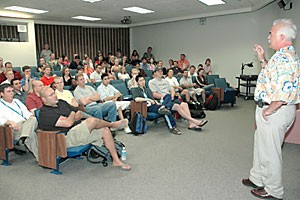First-year medical students were urged to embrace hospice as the crowning stage of complete health care for terminally ill patients during a lecture at the UA College of Medicine on Friday.
Bruce Metzger, volunteer coordinator for Odyssey Healthcare, said he has been working with the university for the last four years to begin a curriculum that would heal the doctor-patient disconnect during the final stages of life.
“”We would love to be able to provide rotations for hospice – and also how to break bad news, to not be afraid,”” said Metzger.
Hospice training isn’t a requirement for graduation from UA’s medical school, mirroring a nationwide trend that lacks exposure to palliative care.
UA students have the option to engage in hospice care during their studies, while other rotations, including radiology and pediatrics, are mandatory, said Metzger.
Tucson representatives of nationwide hospice provider Odyssey Healthcare gave the
We would love to be able to provide rotations for hospice – and also how to break bad news, to not be afraid.
– Bruce Metzger,
volunteer coordinator for Odyssey Healthcare
presentation as part of a case study where students tracked a patient’s fatal progression of pancreatic cancer, said Josh Lopez, director of UA’s Willed Body Program.
Hospice, or “”palliative care,”” combines pain management and spiritual services alongside social and financial counseling for final-stage patients and their family members.
“”I’m very passionate about what we do,”” said Paula Thornton, director of patient services for Odyssey. “”This is the most complete form of medical service I’ve ever seen.””
Patients in hospice must be diagnosed by a physician as terminally ill with less than a year to live, Thornton said.
However, the future doctors need to move past the sense of “”failure and giving up”” when deciding that little else can be done for a patient, said Thornton.
“”Your concern shouldn’t be death, but the quality of how much life is left,”” said Thornton. “”You don’t take away hope – you redirect it.””
A 2003 study by the Dana-Farber Cancer Institute indicated less than 18 percent of medical students and residents were exposed to “”formal end-of-life education.””
Nearly half of those surveyed lacked confidence toward their abilities in consoling terminally ill patients and their families, despite almost unanimous belief that it was within the scope of their responsibilities.
Mike Walston, a first-year medical student, was among a handful of first-year students who lobbed questions toward Metzger and Thornton about hospices’ legal and ethical roles in euthanasia.
Odyssey policy is to have a “”meeting of the minds”” when patients express suicidal notions, where family and professionals amplify emotional support and make sure no means are available – including hoarded painkillers, said Thornton.
“”Ultimately, they’re going to do what they’re going to do,”” said Thornton. “”I can condone it, but I can’t enhance it.””
After the presentation, Walston said he was satisfied with the answers he received from the Odyssey representatives.
“”I think hospice is a great program; it gives a lot of options for these individuals during these periods,”” said Walston. “”I would have a hard time with euthanasia, though.””
The patient who served as the case study – in his mid-40’s – willed his body to the College of Medicine two months prior to his death, said Lopez.
“”This was an opportunity from a generous individual for these students to complete the cycle,”” said Lopez.









